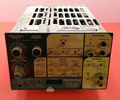Rockland 7530A: Difference between revisions
No edit summary |
No edit summary |
||
| Line 9: | Line 9: | ||
|discontinued=(?) | |discontinued=(?) | ||
|manuals= | |manuals= | ||
* [[Media:Rockland_7530A_FFT_Spectrum_Analyzer_Operating_Manual_1980.pdf|Rockland 7530A | * [[Media:Rockland_7530A_FFT_Spectrum_Analyzer_Operating_Manual_1980.pdf|Rockland 7530A Operating Manual 1980]] | ||
* [[Media:Rockland_7530A_Schematics.pdf|Rockland 7530A Schematics | * [[Media:Rockland_7530A_Schematics.pdf|Rockland 7530A Schematics]] | ||
}} | }} | ||
The (Wavetek) '''Rockland 7530A''' is a | The (Wavetek) '''Rockland 7530A''' is a DC–100 kHz FFT spectrum analyzer plug-in for [[7000-series scopes]]. | ||
Manufacturer was Rockland Scientific Corporation (later acquired by Wavetek). | Manufacturer was Rockland Scientific Corporation (later acquired by [[Wavetek]]). | ||
The Rockland Instruments 7530A and [[ | The Rockland Instruments 7530A and [[Rockland 7530B|7530B]] plugins for Tek 7000 scopes are outstanding, and unique, Spectrum Analyzers. | ||
In the mid-1970s, Rockland Instruments was a small company driven by brilliant engineers who thought outside the box to create state of the art instruments. It was no surprise that Wavetek, which had greater resources and name recognition, bought them several years later to get access to their engineering team. | In the mid-1970s, Rockland Instruments was a small company driven by brilliant engineers who thought outside the box to create state of the art instruments. | ||
It was no surprise that Wavetek, which had greater resources and name recognition, bought them several years later to get access to their engineering team. | |||
In 1976 they were among the first, if not the first, to create a spectrum analyzer using an A/D converter to sample the incoming waveform, convert it into a stream of digital values, perform an FFT (Fast Fourier Transform algorithm) on the data, then use a D/A to convert the results back into the display that appears on the CRT of the 7000 series scope. | In 1976 they were among the first, if not the first, to create a spectrum analyzer using an A/D converter to sample the incoming waveform, convert it into a stream of digital values, perform an FFT (Fast Fourier Transform algorithm) on the data, then use a D/A to convert the results back into the display that appears on the CRT of the 7000 series scope. | ||
| Line 24: | Line 25: | ||
HP was not far behind Rockland Instruments. By comparison Tektronix was so deeply committed to swept-IF Spectrum Analyzers that it took over a decade before they realized the advantages of FFT Spectrum Analyzers. | HP was not far behind Rockland Instruments. By comparison Tektronix was so deeply committed to swept-IF Spectrum Analyzers that it took over a decade before they realized the advantages of FFT Spectrum Analyzers. | ||
The only limitation the 7530 has is due to the speed and performance of microprocessor chips available in the mid-1970s. The only solution at the time that would be fast | The only limitation the 7530 has is due to the speed and performance of microprocessor chips available in the mid-1970s. | ||
The only solution at the time that would be fast and precise enough was to create a 24-bit wide CPU using [[AM25LS381]] bit-slice chips. | |||
The result is a 3-wide 1 Hz to 100 kHz FFT Spectrum Analyzer plugin for the 7000 series scopes that meets or exceeds the specs of the 7L5 in the same frequency range. | The result is a 3-wide, 1 Hz to 100 kHz FFT Spectrum Analyzer plugin for the 7000 series scopes that meets or exceeds the specs of the [[7L5]] in the same frequency range. | ||
{{MissingSpecs}} | {{MissingSpecs}} | ||
Revision as of 02:59, 6 October 2023
The (Wavetek) Rockland 7530A is a DC–100 kHz FFT spectrum analyzer plug-in for 7000-series scopes.
Manufacturer was Rockland Scientific Corporation (later acquired by Wavetek).
The Rockland Instruments 7530A and 7530B plugins for Tek 7000 scopes are outstanding, and unique, Spectrum Analyzers.
In the mid-1970s, Rockland Instruments was a small company driven by brilliant engineers who thought outside the box to create state of the art instruments. It was no surprise that Wavetek, which had greater resources and name recognition, bought them several years later to get access to their engineering team.
In 1976 they were among the first, if not the first, to create a spectrum analyzer using an A/D converter to sample the incoming waveform, convert it into a stream of digital values, perform an FFT (Fast Fourier Transform algorithm) on the data, then use a D/A to convert the results back into the display that appears on the CRT of the 7000 series scope.
HP was not far behind Rockland Instruments. By comparison Tektronix was so deeply committed to swept-IF Spectrum Analyzers that it took over a decade before they realized the advantages of FFT Spectrum Analyzers.
The only limitation the 7530 has is due to the speed and performance of microprocessor chips available in the mid-1970s. The only solution at the time that would be fast and precise enough was to create a 24-bit wide CPU using AM25LS381 bit-slice chips.
The result is a 3-wide, 1 Hz to 100 kHz FFT Spectrum Analyzer plugin for the 7000 series scopes that meets or exceeds the specs of the 7L5 in the same frequency range.
Key Specifications
- please add
Pictures
Components
Some Parts Used in the Rockland 7530A
| Part | Part Number(s) | Class | Description | Used in |
|---|---|---|---|---|
| AM25LS381 | Monolithic integrated circuit | 4-bit ALU slice | Rockland 7530A • Rockland 7530B | |
| Intel 8080 | 156-0954-00 | Monolithic integrated circuit | 8-bit microprocessor | 4024 • 4025 • CT 8101 • Rockland 7530A • Rockland 7530B |






